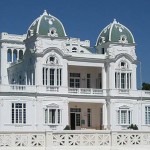Urban Historic Centre of Cienfuegos
Archaeology »
Heritage sites»
Urban Historic Centre of Cienfuegos
Location
Cienfuegos
Country
Cuba
Year of Research
2005
Culture
The colonial town of Cienfuegos was founded in 1819 in the Spanish territory but was initially settled by immigrants of French origin. It became a trading place for sugar cane, tobacco and coffee. Situated on the Caribbean coast of southern-central Cuba at the heart of the country’s sugar cane, mango, tobacco and coffee production area, the town first developed in the neoclassical style. It later became more eclectic but retained a harmonious overall townscape. Among buildings of particular interest are the Government Palace (City Hall), San Lorenzo School, the Bishopric, the Ferrer Palace, the former lyceum, and some residential houses. Cienfuegos is the first, and an outstanding example of an architectural ensemble representing the new ideas of modernity, hygiene and order in urban planning as developed in Latin America from the 19th century.The historic town of Cienfuegos exhibits an important interchange of influences based on the Spanish Enlightenment, and it is an outstanding early example of their implementation in urban planning in Latin America in the 19th century.

